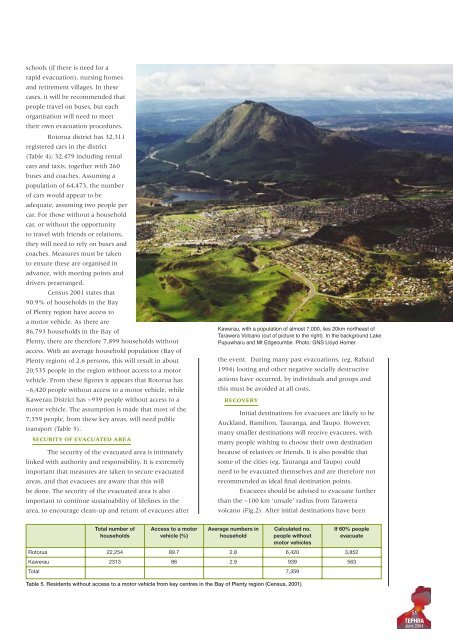evacuate! - Ministry of Civil Defence and Emergency Management
evacuate! - Ministry of Civil Defence and Emergency Management
evacuate! - Ministry of Civil Defence and Emergency Management
Create successful ePaper yourself
Turn your PDF publications into a flip-book with our unique Google optimized e-Paper software.
schools (if there is need for a<br />
rapid evacuation), nursing homes<br />
<strong>and</strong> retirement villages. In these<br />
cases, it will be recommended that<br />
people travel on buses, but each<br />
organisation will need to meet<br />
their own evacuation procedures.<br />
Rotorua district has 32,311<br />
registered cars in the district<br />
(Table 4); 32,479 including rental<br />
cars <strong>and</strong> taxis, together with 260<br />
buses <strong>and</strong> coaches. Assuming a<br />
population <strong>of</strong> 64,473, the number<br />
<strong>of</strong> cars would appear to be<br />
adequate, assuming two people per<br />
car. For those without a household<br />
car, or without the opportunity<br />
to travel with friends or relations,<br />
they will need to rely on buses <strong>and</strong><br />
coaches. Measures must be taken<br />
to ensure these are organised in<br />
advance, with meeting points <strong>and</strong><br />
drivers prearranged.<br />
Census 2001 states that<br />
90.9% <strong>of</strong> households in the Bay<br />
<strong>of</strong> Plenty region have access to<br />
a motor vehicle. As there are<br />
86,793 households in the Bay <strong>of</strong><br />
Plenty, there are therefore 7,899 households without<br />
access. With an average household population (Bay <strong>of</strong><br />
Plenty region) <strong>of</strong> 2.6 persons, this will result in about<br />
20,535 people in the region without access to a motor<br />
vehicle. From these figures it appears that Rotorua has<br />
~6,420 people without access to a motor vehicle, while<br />
Kawerau District has ~939 people without access to a<br />
motor vehicle. The assumption is made that most <strong>of</strong> the<br />
7,359 people, from these key areas, will need public<br />
transport (Table 5).<br />
SECURITY OF EVACUATED AREA<br />
The security <strong>of</strong> the <strong>evacuate</strong>d area is intimately<br />
linked with authority <strong>and</strong> responsibility. It is extremely<br />
important that measures are taken to secure <strong>evacuate</strong>d<br />
areas, <strong>and</strong> that evacuees are aware that this will<br />
be done. The security <strong>of</strong> the <strong>evacuate</strong>d area is also<br />
important to continue sustainability <strong>of</strong> lifelines in the<br />
area, to encourage clean-up <strong>and</strong> return <strong>of</strong> evacuees after<br />
Kawerau, with a population <strong>of</strong> almost 7,000, lies 20km northeast <strong>of</strong><br />
Tarawera Volcano (out <strong>of</strong> picture to the right). In the background Lake<br />
Pupuwharu <strong>and</strong> Mt Edgecumbe. Photo: GNS Lloyd Homer.<br />
the event. During many past evacuations, (eg. Rabaul<br />
1994) looting <strong>and</strong> other negative socially destructive<br />
actions have occurred, by individuals <strong>and</strong> groups <strong>and</strong><br />
this must be avoided at all costs.<br />
RECOVERY<br />
Initial destinations for evacuees are likely to be<br />
Auckl<strong>and</strong>, Hamilton, Tauranga, <strong>and</strong> Taupo. However,<br />
many smaller destinations will receive evacuees, with<br />
many people wishing to choose their own destination<br />
because <strong>of</strong> relatives or friends. It is also possible that<br />
some <strong>of</strong> the cities (eg. Tauranga <strong>and</strong> Taupo) could<br />
need to be <strong>evacuate</strong>d themselves <strong>and</strong> are therefore not<br />
recommended as ideal final destination points.<br />
Evacuees should be advised to <strong>evacuate</strong> further<br />
than the ~100 km ‘unsafe’ radius from Tarawera<br />
volcano (Fig.2). After initial destinations have been<br />
Total number <strong>of</strong><br />
households<br />
Access to a motor<br />
vehicle (%)<br />
Average numbers in<br />
household<br />
Calculated no.<br />
people without<br />
motor vehicles<br />
If 60% people<br />
<strong>evacuate</strong><br />
Rotorua 22,254 89.7 2.8 6,420 3,852<br />
Kawerau 2313 86 2.9 939 563<br />
Total 7,359<br />
Table 5. Residents without access to a motor vehicle from key centres in the Bay <strong>of</strong> Plenty region (Census, 2001)<br />
51<br />
TEPHRA<br />
June 2004
















